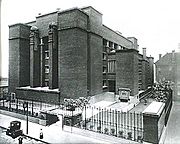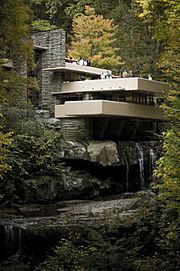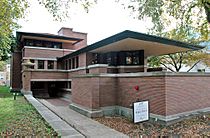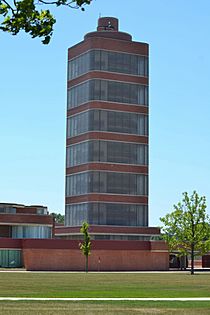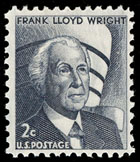Frank Lloyd Wright facts for kids
Quick facts for kids
Frank Lloyd Wright
|
|
|---|---|
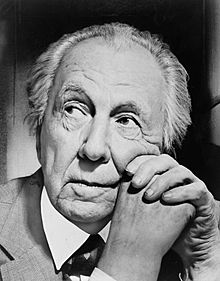 |
|
| Born |
Frank Lincoln Wright
June 8, 1867 |
| Died | April 9, 1959 (aged 91) |
| Cause of death | Surgery |
| Nationality | American |
| Education | Madison High School |
| Alma mater | University of Wisconsin-Madison |
| Home town | Chicago, Illinois |
| Height | 5' 7" (1.70 m) |
| Spouse(s) |
Catherine Wright
(m. 1889–1922)Maude Wright
(m. 1923–1927)Olgivanna Wright
(m. 1928–1959) |
| Children | Lloyd Wright · John Lloyd Wright · Catherine Baxter · Svetlana Milanoff · Catherine Wright · Frances Wright · David Wright · Iovanna Wright |
| Parent(s) | William Carey Wright Anna Lloyd Jones |
| Signature | |
Frank Lloyd Wright (born Frank Lincoln Wright; June 8, 1867 – April 9, 1959) was a very famous American architect. He lived and worked in the early 20th century. He designed many different kinds of buildings. These included banks, vacation spots, offices, churches, and even an art museum.
Wright designed over 1,000 buildings. He finished 532 of them. He believed that buildings should fit in with nature. He called this idea "organic architecture". One of his most famous designs is Fallingwater (1935). Many people call it the best American building ever. Wright also led the Prairie School style of architecture. He also created the idea of the Usonian home. This was his special plan for how homes should be built in the United States.
He created a unique American building style. Many consider him one of the greatest architects of the 1900s.
Wright was born in Richland Center, Wisconsin. This was a farming town. He was born on June 8, 1867.
He designed many creative and original buildings. Wright also designed the inside of his buildings. He made the furniture and stained glass windows. He wrote 20 books and many articles. He was also a popular speaker in the United States and Europe.
Wright was well-known during his life. In 1991, the American Institute of Architects called him "the greatest American architect of all time."
Wright died on April 9, 1959. He passed away in Phoenix, Arizona. This was after a surgery. He was 91 years old.
Contents
Early Life and Education
Frank Lloyd Wright was born in Richland Center, Wisconsin. This was a farming town in the United States. His birthday was June 8, 1867. His birth name was Frank Lincoln Wright.
His father, William Carey Wright, was a music teacher. He was also a lawyer and minister. His mother, Anna Lloyd Jones, was a school teacher. She was from a Welsh family.
The Wright family moved a few times. They lived in Weymouth, Massachusetts. Then they moved back to Spring Green, Wisconsin. Finally, they settled in Madison. Frank's father taught him to love music.
Wright went to Madison High School. He later attended the University of Wisconsin–Madison. He studied there as a special student in 1886. He took classes part-time. He also worked with a professor of civil engineering. In 1887, he moved to Chicago, Illinois.
Beginning His Career
Wright started working as a draftsman. He worked for a company called Adler & Sullivan. The main architect, Louis Sullivan, became his mentor. Wright called Sullivan his Lieber Meister (German for "Dear Master"). This showed his great respect. Wright also became friends with Paul Mueller. Mueller later built many of Wright's public buildings.
Wright started designing houses on his own time. Sullivan did not know about these projects at first. In 1893, Sullivan realized one house was a Wright design. This house was very close to Sullivan's own home.
Many of Wright's buildings are in Buffalo, New York. This was because of his friendship with Darwin D. Martin. In 1902, the Larkin Company wanted a new building. Wright designed the Larkin Administration Building (finished in 1904). He also designed homes for three company leaders. One was the Darwin D. Martin House in 1904. He also designed their summer home, the Graycliff Estate.
Fallingwater: A House Over a Waterfall
In 1935, Frank Lloyd Wright designed a summer house. It was for the Kaufmann family. The house was built over a waterfall in Pennsylvania. He named it "Fallingwater". Some people say it is the most famous private home in the world.
The house sits low in the valley. It is right over the stream. It looks very dramatic from a distance. It has large terraces that stick out. Some even hang over the waterfall. The living room has many windows and glass doors. They wrap all the way around the room.
There are also windows from floor to ceiling. These are in all three stories of the tower.
Most of the house is made from stone. The design has strong horizontal and vertical lines. These lines match the natural rock formations. You can hear the waterfall from everywhere in the house. Wright wanted the house to feel connected to nature. He wanted it to be a natural part of its surroundings.
In 1991, architects called Fallingwater the "best all-time work of American architecture."
Robie House: Unique Design
Another famous house is the Robie House. It was finished in 1910. It had a unique, maze-like layout. It also had geometric stained glass windows. The house had interesting shapes and colors.
Children lived and played in this house until 1926. After that, it was closed to the public. Many times, people planned to tear it down. But Wright saved it twice. He loved the house and its memories. It is now being fixed up. This restoration costs $10 million.
Johnson Wax Headquarters: Modern Style
The Johnson Wax Headquarters is another famous building by Wright. It shows his modern Art Moderne style. This style was popular in the 1930s. Unlike his earlier designs, this building has many circular forms. It used over 200 different curved "Cherokee red" bricks. These bricks created the smooth curves inside and out.
The mortar between the bricks was made to make the building look very horizontal. The warm red color of the bricks was also used in the polished concrete floor. White stone trim and white columns add a striking contrast. All the furniture was designed by Wright. It matched the building's unique features.
The entrance is built into the structure. There is a covered carport on one side. Short, tree-like concrete columns support the carport. These columns are also found inside the main workroom.
The Illinois: A Mile-High Skyscraper
Wright once planned to build a skyscraper called The Illinois. It would have been a mile high! It was meant for Chicago, Illinois. It could have had 528 stories. Wright said it would have parking for 15,000 cars. It would also have space for 150 helicopters. This building was never built.
Solomon R. Guggenheim Museum: A Spiral Masterpiece
The Solomon R. Guggenheim Museum is in New York City. Wright worked on this project for 16 years (1943–1959). It is one of his most famous works. The building is on Fifth Avenue. Its inside looks like a seashell.
Its unique spiral shape lets visitors easily see the art. You take an elevator to the top. Then you walk down a gently sloping ramp. This ramp spirals down through the museum. The floor has circular shapes and triangular lights. These match the building's geometric design.
However, some of Wright's ideas were not followed. For example, he wanted the inside to be off-white. Also, the museum now often sets up exhibits to be viewed by walking up the ramp, not down.
Later Career and Legacy
Wright preferred to work alone. He did not always agree with the American Institute of Architects. In 1940, Wright started the Frank Lloyd Wright Foundation. This foundation was for education. It takes care of two of Wright's buildings. These are Taliesin East in Wisconsin and Taliesin West in Arizona. The foundation has a huge library. It holds over 22,000 of Wright's drawings. It also has 300,000 documents. It is also home to the Frank Lloyd Wright School of Architecture.
Personal Life
Frank Lloyd Wright was married three times. He had seven children. He had four sons and three daughters. He also adopted his third wife's daughter, Svetlana Milanoff.
His wives were:
- Catherine "Kitty" Wright (married 1889; divorced 1922)
- Maude "Miriam" Wright (married 1923; divorced 1927)
- Olga Ivanovna "Olgivanna" Lloyd Wright (married 1928)
The famous actress Anne Baxter was Wright's granddaughter.
Wright loved Japanese Art. He collected many pieces throughout his life. He often sold these prints to help pay for loans. His art business helped him financially.
Death and Burial
Wright died on April 9, 1959. He passed away during surgery in Phoenix, Arizona. He was 91 years old. His third wife, Olgivanna, managed his foundation after he died. She passed away in 1985.
Later that year, Olgivanna's last wish was carried out. She wanted Wright, herself, and her daughter to be cremated. Their ashes were to be moved to Scottsdale, Arizona. Wright's body had been buried for over 25 years. He was in the Lloyd-Jones cemetery in Wisconsin. This was near his home, Taliesin. Members of the Taliesin Fellowship moved his remains. They were cremated and sent to Scottsdale. His ashes are now in a memorial garden there.
His Impact
In 1966, the United States Postal Service honored Wright. They put him on a 2¢ postage stamp. Several of Wright's buildings have been suggested to become UNESCO World Heritage sites. These are special places recognized around the world.
After his death, the music group Simon & Garfunkel recorded a song. It was called So Long, Frank Lloyd Wright. It was a tribute to him.
In 2000, Fallingwater was named "The Building of the 20th century." This was in a poll by architects. Wright was the only architect with more than one building on the list. His other buildings on the list were the Guggenheim Museum, the Frederick C. Robie House, and the Johnson Wax Headquarters.
Images for kids
-
Wright's home in Oak Park, Illinois (1889)
-
William H. Winslow House in River Forest, Illinois (1893)
-
Wright's studio viewed from Chicago Avenue (1898)
-
Arthur Heurtley House, Oak Park, Illinois (1902)
-
Hillside Home School, Taliesin, Spring Green, Wisconsin (1902)
-
Solomon R. Guggenheim Museum, New York City (1959)
-
Price Tower in Bartlesville, Oklahoma (1956)
-
Wright-designed window in Robie House, Chicago (1906)
-
Interior from the Marin County Civic Center. Designed toward the end of Wright's life.
-
Imperial Hotel, Tokyo (1923)
 In Spanish: Frank Lloyd Wright para niños
In Spanish: Frank Lloyd Wright para niños


